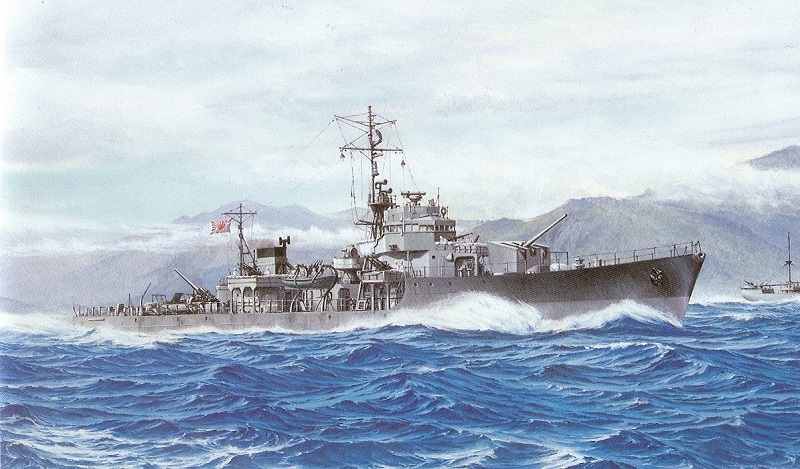© 2006-2009 Bob Hackett, Sander Kingsepp and Peter Cundall
Revision 1
14 February 1944:
Tsurumi. Laid down at Nippon Kokan K.Kís Kanagawa shipyard
as kaibokan No. 336.
30 November 1944:
Launched and named AMAMI.
April 1945:
A Type 13 air-search radar is installed.
8 April 1945:
Completed and registered in the Maizuru Naval District.
Attached to the Kure Guard Unit at Tsurumi, Kyushu.
9 April 1945:
Departs Tsurumi. Arrives at Tateyama, near Tokyo.
13 April 1945:
Departs Tateyama.
15 April 1945:
Arrives at Yamada Bay, Iwate Prefecture.
18 April 1945:
Departs Hakodate, Hokkaido.
19 April 1945:
Departs Minmaya, Aomori prefecture.
20 April 1945:
Arrives at Nanao Bay, Honshu. Undergoes training with the Kure Guard Unit and participates in anti-submarine exercises.
5 May 1945:
Completes training and departs Nanao Bay.
6 May 1945:
Maizuru Naval Arsenal. Drydocked.
27 May 1945:
Reassigned to the First Escort Fleet's 31st Coast Defense Squadron.
2 July 1945:
Departs Maizuru.
4 July 1945:
Arrives at Ominato, Honshu.
7 July 1945:
Departs Ominato.
9 July 1945:
Arrives at Wakkanai, Hokkaido. Guards the La Perouse/Soya
strait with minelayer TOKIWA.
21 July 1945:
Departs Wakkanai.
23 July 1945:
Arrives at Ominato.
15 August 1945:
AMAMIís crew is notified of the termination of the war while escorting a convoy from Nanao to Korea. AMAMI reverses course.
22 August 1945:
Arrives at Maizuru.
25 September 1945:
Reassigned to the Maizuru Naval District.
5 October 1945:
Removed from the Navy List.
2 October 1945:
Departs Maizuru.
5 October 1945:
Removed from the Navy List. That same day,
arrives at Sasebo and departs later that day on her first repatriation transport voyage.
14 October 1945:
Arrives at Wotje. Embarks troops and passengers to be repatriated and departs later that day.
16 October 1945:
Arrives at Truk. Embarks troops and passengers to be repatriated and departs later that day.
20 October 1945:
Arrives at Wotje. Embarks troops and passengers to be repatriated and departs later that day.
27 October 1945:
Arrives at Uraga. Disembarks troops and passengers
28 October 1945:
Undergoes repairs at Yokohama.
19 November 1945:
Completes repairs.
21 November 1945:
Departs Yokohama.
26 November 1945:
Arrives at Guam. Embarks troops and passengers to be repatriatedand departs later that day.
30 November 1945:
Arrives at Truk. Embarks troops and passengers to be repatriated and departs later that day.
1 December 1945:
Officially assigned to the Allied Repatriation Service. [1]
6 December 1945:
Arrives at Uraga. Disembarks troops and passengers
8 December 1945:
Undergoes repairs at Yokohama.
15 January 1946:
Completes repairs.
20 January 1946:
Departs Uraga. Disembarks troops and passengers
26 January 1946:
Arrives at Guam, Embarks troops and passengers to be repatriatedand departs later that day.
28 January 1946:
Arrives at Saipan. Embarks troops and passengers to be repatriated and departs later that day.
3 February 1946:
Arrives at Okinawa. Embarks troops and passengers to be repatriated and departs later that day.
5 February 1946:
Arrives at Otaka. Disembarks troops and passenger and departs later that day.
7 February 1946:
Arrives at Kure.
10 February 1946:
Undergoes repairs at Tamano.
28 February 1946:
Completes repairs.
15 March 1946:
Departs Sasebo.
18 March 1946:
Arrives at Shanghai. Embarks troops and passengers to be repatriated and departs later the same day.
21 March 1946:
Arrives at Sasebo. Disembarks troops and passengers
25 March 1946:
Departs Sasebo.
27 March 1946:
Arrives at Shanghai. Embarks troops and passengers to be repatriated.
28 March 1946:
Departs Shanghai.
30 March 1946:
Arrives at Sasebo. Disembarks troops and passengers
7 April 1946:
Departs Sasebo.
10 April 1946:
Arrives at Shanghai. Embarks troops and passengers to be repatriated.
12 April 1946:
Departs Shanghai.
15 April 1946:
Arrives at Sasebo. Disembarks troops and passengers
22 April 1946:
Departs Sasebo.
25 April 1946:
Arrives at Shanghai. Embarks troops and passengers to be repatriated.
26 April 1946:
Departs Shanghai.
28 April 1946:
Arrives at Sasebo. Disembarks troops and passengers
5 May 1946:
Departs Sasebo.
6 May 1946:
Arrives at Shanghai. Embarks troops and passengers to be repatriated.
10 May 1946:
Departs Shanghai.
12 May 1946:
Arrives at Sasebo. Disembarks troops and passengers
18 May 1946:
Departs Sasebo.
19 May 1946:
Arrives at Maizuru.
20 May 1946:
Undergoes repairs.
2 June 1946:
Completes repairs.
10 June 1946:
Departs Sasebo.
12 June 1946:
Arrives at Shanghai. Embarks troops and passengers to be repatriated and departs later the same day.
15 June 1946:
Arrives at Sasebo. Disembarks troops and passengers
15 July 1946:
Undergoes repairs.
30 July 1946:
Completes repairs.
10 September 1947:
Ceded to the United Kingdom as a war reparation.
20 December 1947:
Hiroshima. Scrapped at Mitsubishi Heavy Industries,
Ltdís shipyard. The hull becomes a floating (pontoon) pier at the shipyard until 1982.
Authors' Notes:
[1] Allied occupation forces were responsible for the return of six million Japanese military personnel and civilians from Japan's defunct far-flung Empire. In addition, there were over a million Korean and about 40,000 Chinese prisoners and conscript laborers and approximately 7,000 Formosans and 15,000 Ryukyu Islanders to be repatriated.
Some Allied and many former IJN warships, from aircraft carriers to kaibokan, were used to facilitate the enormous repatriation effort. Japanese vessels and crews were used to the fullest extent possible to conserve Allied manpower and accelerate demobilization. Each ex-IJN ship first had to be demilitarized; guns removed or, in the case of large warships, barrels severed, ammunition landed, and radar and catapults removed, if fitted. Repatriation of the Chinese on Japanese ships began early in October from Hakata, but U.S. guard detachments had to be placed on many ships to prevent disorder because the Japanese crews could not control the returnees.
Japanese-run repatriation centers were established at Kagoshima, Hario near Sasebo, and Hakata near Fukuoka. Allied line and medical personnel supervised the centers. Incoming Japanese were sprayed with DDT, examined and inoculated for typhus and smallpox, provided with food, and transported to his final destination in Japan.
Thanks go to Dr. Higuchi Tatsuhiro of Japan.
-Bob Hackett, Sander Kingsepp and Peter Cundall
Back to
Escort Page



